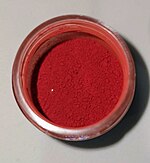Mercury sulfide

| |
| Names | |
|---|---|
| IUPAC name
Mercury sulfide
| |
| Other names | |
| Identifiers | |
3D model (
JSmol ) |
|
ECHA InfoCard
|
100.014.270 |
| EC Number |
|
PubChem CID
|
|
| UNII | |
| UN number | 2025 |
CompTox Dashboard (EPA)
|
|
| |
| |
| Properties | |
| HgS | |
| Molar mass | 232.66 g/mol |
| Density | 8.10 g/cm3 |
| Melting point | 580 °C (1,076 °F; 853 K) decomposes |
| insoluble | |
| Band gap | 2.1 eV (direct, α-HgS) [1] |
| −55.4·10−6 cm3/mol | |
Refractive index (nD)
|
w=2.905, e=3.256, bire=0.3510 (α-HgS) [2] |
| Thermochemistry | |
Std molar
entropy (S⦵298) |
78 J·mol−1·K−1[3] |
Std enthalpy of (ΔfH⦵298)formation |
−58 kJ·mol−1[3] |
| Hazards | |
| GHS labelling: | |
   
| |
| Danger | |
| H300, H310, H317, H330, H373, H410 | |
| P261, P272, P280, P302+P352, P321, P333+P313, P363, P501 | |
| NFPA 704 (fire diamond) | |
| Flash point | Non-flammable |
| Safety data sheet (SDS) | Fisher Scientific |
| Related compounds | |
Other anions
|
Mercury oxide mercury selenide mercury telluride |
Other cations
|
Zinc sulfide cadmium sulfide |
Except where otherwise noted, data are given for materials in their standard state (at 25 °C [77 °F], 100 kPa).
| |
Mercury sulfide, or mercury(II) sulfide is a chemical compound composed of the
Crystal structure


HgS is dimorphic with two crystal forms:
- red optically active. This is caused by the Hg-S helices in the structure.[5]
- black zinc blende crystal structure(T2d-F43m).
Preparation and chemistry
β-HgS precipitates as a black solid when Hg(II) salts are treated with
Mercury is produced from the cinnabar ore by roasting in air and condensing the vapour.[4]
- HgS → Hg + S
Uses

When α-HgS is used as a red pigment, it is known as vermilion. The tendency of vermilion to darken has been ascribed to conversion from red α-HgS to black β-HgS. However β-HgS was not detected at excavations in Pompeii, where originally red walls darkened, and was attributed to the formation of Hg-Cl compounds (e.g., corderoite, calomel, and terlinguaite) and calcium sulfate, gypsum.[7]
As the mercury cell as used in the chlor-alkali industry (Castner–Kellner process) is being phased out over concerns over mercury emissions, the metallic mercury from these setups is converted into mercury sulfide for underground storage.
With a band gap of 2.1 eV and its stability, it is possible to be used as photoelectrochemical cell.[8]
See also
- Mercury poisoning
- Mercury(I) sulfide (mercurous sulfide, Hg
2S), hypothetical
References
- ISBN 0-8493-8912-7
- ^ Webminerals
- ^ ISBN 978-0-618-94690-7.
- ^ ISBN 978-0-08-022057-4.
- S2CID 96545158.
- ISBN 9780470132326.
- PMID 17073416.
- S2CID 4363745.

